Ruggero Ruggeri (1871-1953) was one the most important Italian stage actors of the first half of the twentieth century, who often performed the plays by Pirandello. He did act in films too, both in silent and sound films. Nowadays, he is best remembered as the voice of Jesus in the Don Camillo films.
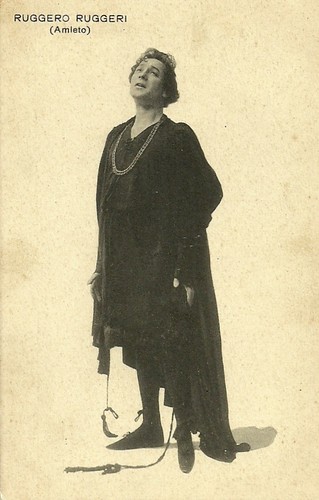
Italian postcard, no. 8067. Photo: Ruggero Ruggeri as Hamlet, either on stage or in the film Amleto (Eleuterio Rodolfi, 1917).
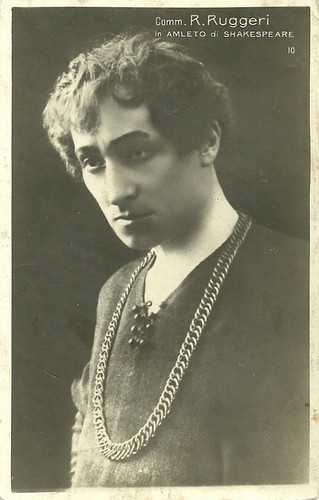
Italian postcard, no. 10. Editor unknown. Ruggero Ruggeri as Hamlet.
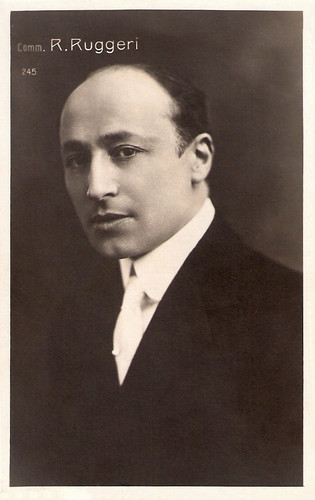
Italian postcard by Ed. Vettori, Bologna, no. 245.

Italian postcard by Ed. A. Traldi, Milano. Photo: S.A.I.C. Ruggero Ruggeri in L'uomo più allegro di Vienna/The Most Cheerful Man in Vienna (Amleto Palermi, 1925).
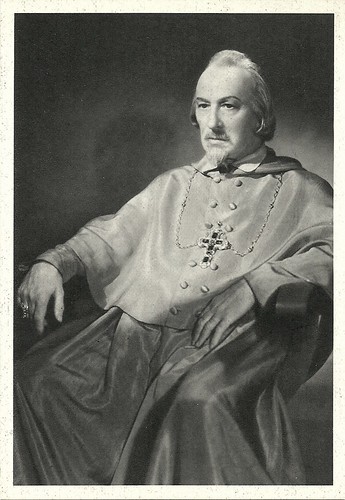
Italian postcard by S.A. Grafitalia, Milano (Milan), no. 10. Photo: Film Lux. Ruggero Ruggeri as Cardinal Federigo Borromeo in I Promessi Sposi/The Spirit and the Flesh (Mario Camerini, 1941).
Ruggero Ruggeri was born in Fano, in the Italian region Marches in 1871. His father was Augusto Ruggeri and his mother Corina Casazza.
As an actor, he broke with the histrionic acting style, so typical for 19th-century theatre and instead opted for a more restrained, sober style, only with some stylisation of his gestures.
His multi-coloured voice was very popular. He was famous for his role in 'La figlia di Jorio' (The Daughter of Jorio) by Gabriele D'Annunzio, but he was also the most important performer of Luigi Pirandello's stage plays, such as 'Enrico IV'(Henry IV), purposely written for Ruggeri.
Ruggeri was leader of various theatre companies, with actresses such as Emma Grammatica, Lyda Borelli, and Wanda Capodaglio with whom he was also glorified abroad, because of their frequent tours.

French postcard. Photo: Nunes-Vais.
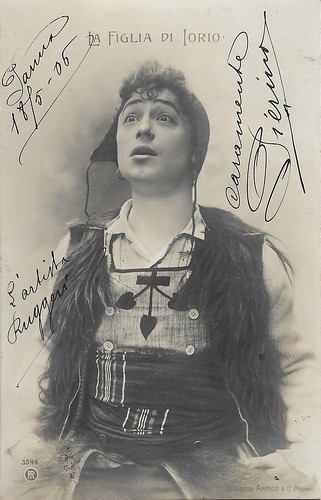
Italian postcard by RPH, no. 3546. Photo: Varischi Artico.& Co., Milano. Mailed 18 May 1906. Ruggero Ruggeri in the stage play La figlia di Jorio (1906).

Italian postcard by R. Rota Ed., Milano. Photo: cav. G. Artico, Milano.
From 1914 on, Ruggero Ruggeri played in eleven silent films.
First, he was seen in a series of dramas and comedies for the Cines company, like Veli di giovinezza/Veils of Youth (Nino Oxilia, 1914) and Papa (Nino Oxilia, 1915).
At Cines, Ruggeri was often paired with diva Pina Menichelli. Director Nino Oxilia was killed in service during the First World War, shortly after Italy joined the Allied forces.
In 1917 Ruggeri followed this with a memorable film adaptation of William Shakespeare's Hamlet: Amleto (Eleuterio Rodolfi, 1917), with Helena Makowska as Ophelia and Mercedes Brignone as Gertrude. Outside of Italy the film was released only after the war.
In the mid-1920s, Ruggeri would perform in films by Amleto Palermi and Augusto Genina, and in 1930 he appeared opposite Francesca Bertini in La donna di una notte/The Woman of A Night, the Italian version of Königin der Nacht, directed by Marcel L'Herbier, who demanded his name be to be removed, because the film was edited without his consent.
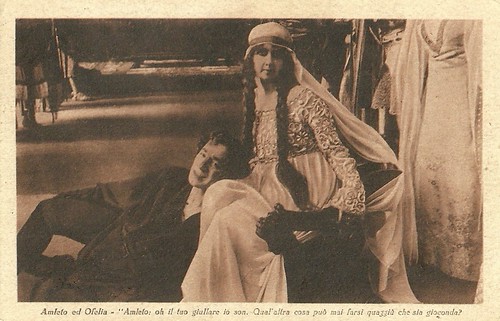
Italian postcard for the film Amleto (Eleuterio Rodolfi, 1917), adapted from Shakespeare's play Hamlet, and starring Ruggero Ruggeri in the title role, here also with Helena Makowska as Ophelia. Caption: Hamlet: Oh, I am your jester. What else can one ever do down here that is joyous?

Italian postcard. Ruggero Ruggeri as Hamlet in Amleto (Eleuterio Rodolfi, 1917). The caption says: Horatio and Marcellus tell Hamlet of their vision of the ghost. Hamlet responds (Shakespeare's words): 'Upon the platform, 'twixt eleven and twelve, I'll visit you.'
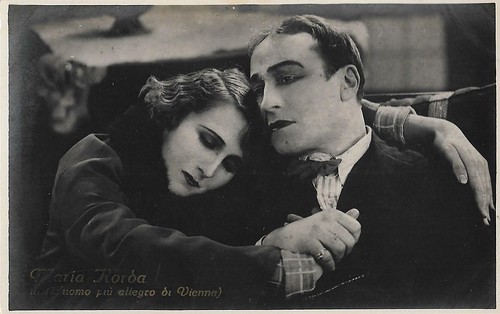
Italian postcard. Photo: Palermi Films. Maria Corda and Ruggero Ruggeri in L'uomo più allegro di Vienna (Amleto Palermi, 1925).
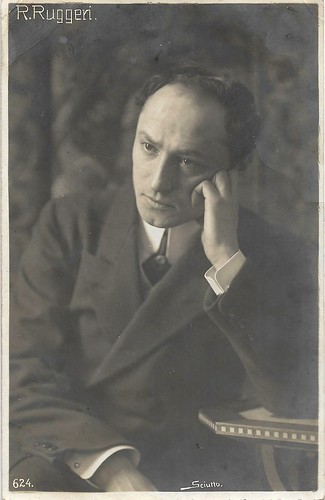
Italian postcard, no. 624. Photo: Sciutto.
In the late 1930s and early 1940s, when Ruggero Ruggeri was already in his sixties and seventies, he performed in ten Italian films, often as the lead, for companies as Scalera and Lux.
These films included La vedova/The Widow (Goffredo Alessandrini, 1939), Il documento/The Document (Mario Camerini, 1939) with María Denis, and I promesi sposi/The Spirit and the Flesh (Mario Camerini, 1941) with Gino Cervi.
He also appeared in Gelosia/Jealousy (Ferdinando Maria Poggioli, 1942), and played Napoleon in Sant'Elena, piccola isola/Daint Helens - Small Island (Umberto Scarpelli, Renato Simoni, 1942). He also worked as a voice actor, dubbing foreign actors for Italian release.
Ruggeri's best known performance today is only oral. Most older Italians will know him as the voice of Jesus in Don Camillo (1952) and in Le retour de Don Camillo/The Return of Don Camillo (1953), both directed by Julien Duvivier.
Ruggero Ruggeri died in Milano in 1953. He was 81. Ruggeri was interred at the Cimitero Monumentale di Milano in Milan.
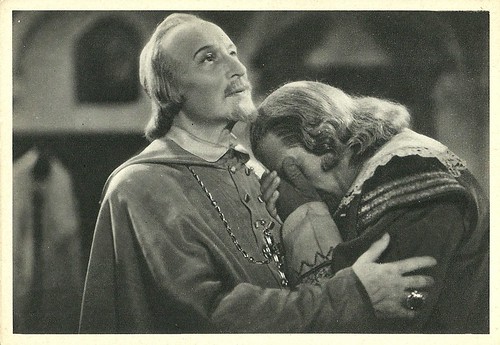
Italian postcard by SA Grafitalia, Roma. Photo: Lux Film. Ruggero Ruggeri as Cardinal Federigo Borromeo offers solace to the repenting Innominato (Carlo Ninchi) in I Promessi Sposi/The Spirit and the Flesh (Mario Camerini, 1941).
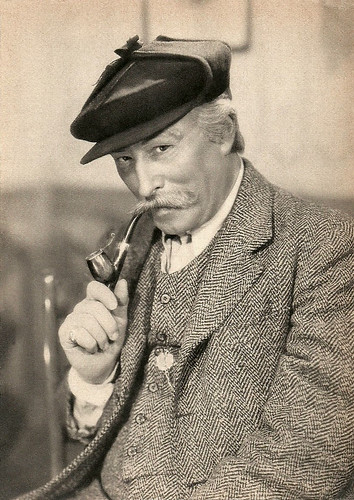
Italian postcard by Rotocalco Dagnino, Torino. Photo: Lux. Ruggero Ruggeri as Papà Martin in the drama La gerla di papà Martin (Mario Bonnard, 1940), an adaptation by the Italian Lux company of the popular drama Les crochets du père Martin by Eugène Cormon and Eugène Grangé. Among Ruggeri's co-actors in this film were Germana Paolieri, Roberto Villa, Enrico Glori and Maria Mercader.
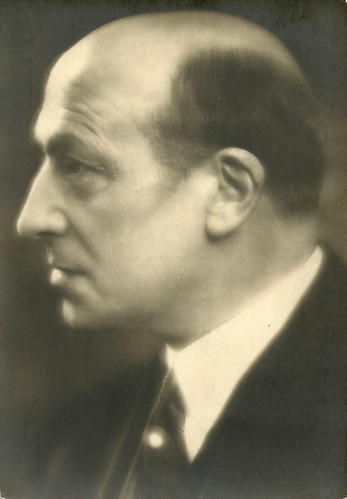
Italian postcard by Alterocca, Terni XIX [1941], no. 7097. Photo: Camuzzi.
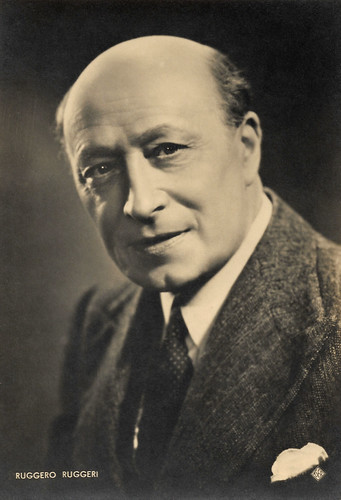
Italian postcard by ASER (A. Scaramaglia Edizioni Roma), no. 64. Photo: Pesce.
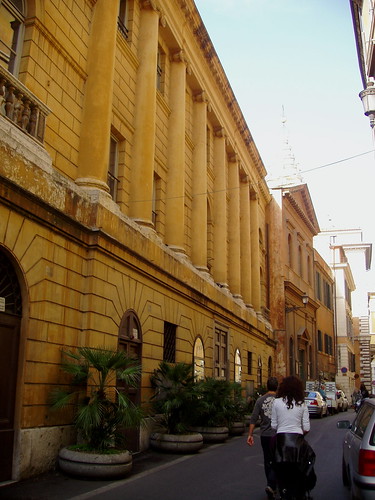
Sources: Wikipedia (Italian) and IMDb.

Italian postcard, no. 8067. Photo: Ruggero Ruggeri as Hamlet, either on stage or in the film Amleto (Eleuterio Rodolfi, 1917).

Italian postcard, no. 10. Editor unknown. Ruggero Ruggeri as Hamlet.

Italian postcard by Ed. Vettori, Bologna, no. 245.

Italian postcard by Ed. A. Traldi, Milano. Photo: S.A.I.C. Ruggero Ruggeri in L'uomo più allegro di Vienna/The Most Cheerful Man in Vienna (Amleto Palermi, 1925).

Italian postcard by S.A. Grafitalia, Milano (Milan), no. 10. Photo: Film Lux. Ruggero Ruggeri as Cardinal Federigo Borromeo in I Promessi Sposi/The Spirit and the Flesh (Mario Camerini, 1941).
Multi Colored Voice
Ruggero Ruggeri was born in Fano, in the Italian region Marches in 1871. His father was Augusto Ruggeri and his mother Corina Casazza.
As an actor, he broke with the histrionic acting style, so typical for 19th-century theatre and instead opted for a more restrained, sober style, only with some stylisation of his gestures.
His multi-coloured voice was very popular. He was famous for his role in 'La figlia di Jorio' (The Daughter of Jorio) by Gabriele D'Annunzio, but he was also the most important performer of Luigi Pirandello's stage plays, such as 'Enrico IV'(Henry IV), purposely written for Ruggeri.
Ruggeri was leader of various theatre companies, with actresses such as Emma Grammatica, Lyda Borelli, and Wanda Capodaglio with whom he was also glorified abroad, because of their frequent tours.

French postcard. Photo: Nunes-Vais.

Italian postcard by RPH, no. 3546. Photo: Varischi Artico.& Co., Milano. Mailed 18 May 1906. Ruggero Ruggeri in the stage play La figlia di Jorio (1906).

Italian postcard by R. Rota Ed., Milano. Photo: cav. G. Artico, Milano.
Silent Era
From 1914 on, Ruggero Ruggeri played in eleven silent films.
First, he was seen in a series of dramas and comedies for the Cines company, like Veli di giovinezza/Veils of Youth (Nino Oxilia, 1914) and Papa (Nino Oxilia, 1915).
At Cines, Ruggeri was often paired with diva Pina Menichelli. Director Nino Oxilia was killed in service during the First World War, shortly after Italy joined the Allied forces.
In 1917 Ruggeri followed this with a memorable film adaptation of William Shakespeare's Hamlet: Amleto (Eleuterio Rodolfi, 1917), with Helena Makowska as Ophelia and Mercedes Brignone as Gertrude. Outside of Italy the film was released only after the war.
In the mid-1920s, Ruggeri would perform in films by Amleto Palermi and Augusto Genina, and in 1930 he appeared opposite Francesca Bertini in La donna di una notte/The Woman of A Night, the Italian version of Königin der Nacht, directed by Marcel L'Herbier, who demanded his name be to be removed, because the film was edited without his consent.

Italian postcard for the film Amleto (Eleuterio Rodolfi, 1917), adapted from Shakespeare's play Hamlet, and starring Ruggero Ruggeri in the title role, here also with Helena Makowska as Ophelia. Caption: Hamlet: Oh, I am your jester. What else can one ever do down here that is joyous?

Italian postcard. Ruggero Ruggeri as Hamlet in Amleto (Eleuterio Rodolfi, 1917). The caption says: Horatio and Marcellus tell Hamlet of their vision of the ghost. Hamlet responds (Shakespeare's words): 'Upon the platform, 'twixt eleven and twelve, I'll visit you.'

Italian postcard. Photo: Palermi Films. Maria Corda and Ruggero Ruggeri in L'uomo più allegro di Vienna (Amleto Palermi, 1925).

Italian postcard, no. 624. Photo: Sciutto.
The Voice of Jesus
In the late 1930s and early 1940s, when Ruggero Ruggeri was already in his sixties and seventies, he performed in ten Italian films, often as the lead, for companies as Scalera and Lux.
These films included La vedova/The Widow (Goffredo Alessandrini, 1939), Il documento/The Document (Mario Camerini, 1939) with María Denis, and I promesi sposi/The Spirit and the Flesh (Mario Camerini, 1941) with Gino Cervi.
He also appeared in Gelosia/Jealousy (Ferdinando Maria Poggioli, 1942), and played Napoleon in Sant'Elena, piccola isola/Daint Helens - Small Island (Umberto Scarpelli, Renato Simoni, 1942). He also worked as a voice actor, dubbing foreign actors for Italian release.
Ruggeri's best known performance today is only oral. Most older Italians will know him as the voice of Jesus in Don Camillo (1952) and in Le retour de Don Camillo/The Return of Don Camillo (1953), both directed by Julien Duvivier.
Ruggero Ruggeri died in Milano in 1953. He was 81. Ruggeri was interred at the Cimitero Monumentale di Milano in Milan.

Italian postcard by SA Grafitalia, Roma. Photo: Lux Film. Ruggero Ruggeri as Cardinal Federigo Borromeo offers solace to the repenting Innominato (Carlo Ninchi) in I Promessi Sposi/The Spirit and the Flesh (Mario Camerini, 1941).

Italian postcard by Rotocalco Dagnino, Torino. Photo: Lux. Ruggero Ruggeri as Papà Martin in the drama La gerla di papà Martin (Mario Bonnard, 1940), an adaptation by the Italian Lux company of the popular drama Les crochets du père Martin by Eugène Cormon and Eugène Grangé. Among Ruggeri's co-actors in this film were Germana Paolieri, Roberto Villa, Enrico Glori and Maria Mercader.

Italian postcard by Alterocca, Terni XIX [1941], no. 7097. Photo: Camuzzi.

Italian postcard by ASER (A. Scaramaglia Edizioni Roma), no. 64. Photo: Pesce.

Teatro Valle, Rome. Ruggero Ruggeri and Lyda Borelli often performed in this prominent Roman theatre. The Teatro Valle was built in 1727 as a wooden structure by Tommaso Morelli, enlarged and turned into stone in 1765 by architect Francesco Fiori and radically transformed, embellished and enlarged in 1821 by architect Giuseppe Valadier. Photo: Ivo Blom.
Sources: Wikipedia (Italian) and IMDb.
No comments:
Post a Comment